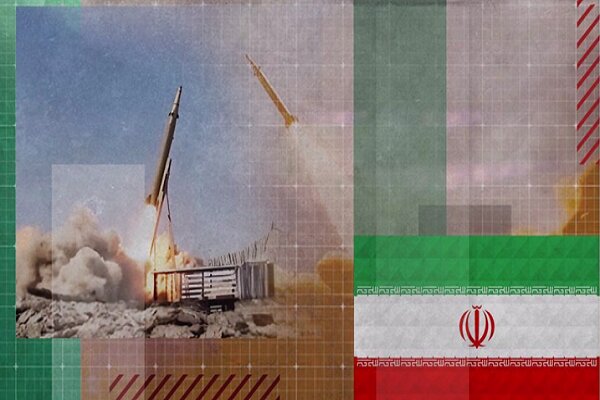The new missile is an upgraded version of the Haj Qassem missile, which has been providing operational services for five years.
Iran’s defense minister, General Aziz Nasirzadeh, told the state broadcaster that the missiles have been strengthened in terms of both guidance and maneuverability compared to previous missiles.
He also pointed out that Qassem Basir will be immunized by the air defense systems of the US Thaad and Patriot, as well as the layered arrow system of the Israeli regime.
Iranian television broadcasts related footage from the ballistic test reportedly conducted on April 17th, showing the launch of the Qassem Basir and its precise impact on designated targets in the natural environment.
Nasirzadeh pointed out that severe electronic interference was applied to the missile during testing but was not affected.
The missile reportedly has high maneuverability, derived from experience in two retaliatory operations last year, known as true promises to the Zionist regime, 1 and 2.
What is the predecessor of Hajikasem?
Haj Qassem is a two-stage tactical solid fuel quasi-ballistic missile announced in August 2020 and named after Iranian commander Qassem Soleimani.
The total mass of the missile is 7 tons, weighing 500 kilograms of warhead and 11 meters long. Its atmospheric entry speed is Mach 11, its impact speed is Mach 5, which places it in the high-sonic domain.
The reported range for the Haj Qassem is 1,400 km, and at the time of its announcement it was stated that the missile was designed to expand its range to 1,800 km.
In 2023, when the late President Ebrahim Reisi visited the Defense Achievements Exhibition, the new capabilities of the Haji Kasem missile were demonstrated, significantly reducing preparation and launch times compared to previous systems.
This improvement comes from a modification of missiles to the platform structure, allowing for much faster preparation and launches than previous models.
Experts believe that missile systems employ dynamic reference unit (DRU) technology that provides real-time, accurate directional data such as pitch, roll and yaw by integrating accelerometers, gyroscopes and sometimes magnetometers.
With the help of this system, the Transporter Erector Launcher (TEL) begins to fire immediately after deployment and erection, and can quickly fold the firing site to be empty.
The technology is also incorporated into the Kheibar Shekan and Fateh missile systems, which reduces preparation time by sixth compared to other missiles, according to Brigadier General Amir Ali Hajizadeh.
What improvements does Qassem Basir offer?
Based on statements from military officials and launch footage, Qassem Basir shares many similarities with Haj Qassem in terms of dimensions and capabilities, using the same launch platform.
Both missiles have eight stabilizing fins at the rear end, and although they do not have the thrust vector control present in other Iranian missile systems, they achieve sufficient maneuverability through aerodynamic control surfaces and orbital adjustments at the end phase.
There are two differences between Kasem Bashir and Haj Kasem when it comes to warhead upgrades. In particular, the guidance system and operability.
Iranian ballistic missiles, including Haj Qassem, mainly use a combination of global positioning systems (GPS) and inertial navigation systems (INS).
These two features allow missiles to fly based on GPS data from the first phase of orbit to the intermediate phase, using INS guidance at the final stage.
The reason for this is that GPS can be destroyed by electronic warfare (EW) activities, and the enemy certainly uses a variety of EW methods to destroy missile guidance, deflect ballistic missiles, and cause errors in targeting.
Meanwhile, INS uses several gyroscopes and accelerometers to guide missiles towards the target by calculating angular velocity and preventing missile deviations.
However, since Insu-guided missiles modify their course based on physical and atmospheric variables and are based on the missile’s high speed at the final stage of their movement, the accuracy of the missile is reduced compared to GPS guidance.
The Qassem Basir missile optical guidance was introduced due to its experience in anti-Israel operations, particularly the need for high precision to hit targets such as hangars, and at the same time, it is immune to electronic clogging.
Optical guidance, especially thermal imaging cameras, not only significantly improve hit accuracy, but are also resistant to electronic warfare and external jamming.
One limitation of this guidance method is the reduction in missile range. This is also the reason for reducing the range of casem bus missiles compared to casem missiles.
Despite this 200km reduction, the range of the Qassem Basir missile is sufficient to reach the occupied Palestinian territory.
It should be noted that optical guidance was used in various early Iranian short-range ballistic missiles, but its range is almost 300 or 500 km, significantly less than the Qassem Basir.
These guidance capabilities allow new missiles to collide even at most selective targets, such as hangar entrances and sea vessel movements.
The released video for the Qassem Basir missile test shows that the marked square target hits just in the center, suggesting that accuracy is measured with a decimeter rather than a meter.
Another feature implemented in the Qasem Basir missile is its warhead maneuverability, as all world air defense systems are vulnerable to missiles that are capable of changing courses at supersonic or hypersensitivity speeds.
MNA/presstv

